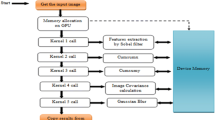Abstract
In this paper, we present an OpenCL-based heterogeneous implementation of a computer vision algorithm – image inpainting-based object removal algorithm – on mobile devices. To take advantage of the computation power of the mobile processor, the algorithm workflow is partitioned between the CPU and the GPU based on the profiling results on mobile devices, so that the computationally-intensive kernels are accelerated by the mobile GPGPU (general-purpose computing using graphics processing units). By exploring the implementation trade-offs and utilizing the proposed optimization strategies at different levels including algorithm optimization, parallelism optimization, and memory access optimization, we significantly speed up the algorithm with the CPU-GPU heterogeneous implementation, while preserving the quality of the output images. Experimental results show that heterogeneous computing based on GPGPU co-processing can significantly speed up the computer vision algorithms and makes them practical on real-world mobile devices.















Similar content being viewed by others
Notes
In this case, the candidate patch is in the area of (S A−O A).
In this case, the candidate patch is in the area of OA.
References
Bordallo Lopez, M, Nykänen, H, Hannuksela, J, Silven, O, Vehviläinen, M. (2011). Accelerating image recognition on mobile devices using GPGPU. Proceeding of SPIE (Vol. 7872, p. 78720R).
Cheng, KT, & Wang, Y. (2011). Using mobile GPU for general-purpose computing - a case study of face recognition on smartphones. Proceedings of IEEE international symposium VLSI design, automation and test (VLSI-DAT) (pp. 1–4). doi:10.1109/VDAT.2011.5783575.
Clemons, JL ((2013)). Computer architectures for mobile computer vision systems. Ph.D. Thesis, University of Michigan. URL http://hdl.handle.net/2027.42/97782.
Criminisi, A, Perez, P, Toyama, K. (2003). Proceedings in IEEE conference computer vision and pattern recognition (CVPR) (Vol. 2, pp. 721–728). doi:10.1109/CVPR.2003.1211538.
Ensor, A, & Hall, S (2011). GPU-based image analysis on mobile devices. arXiv:11123110.
Fernández, V, Orduna, JM, Morillo, P. (2012). Performance characterization of mobile phones in augmented reality marker tracking. International conference of computational and mathematical methods in science and engineering (CMMSE) (pp. 537–549).
Google (2013). Android Development Guide. URL http://developer.android.com/index.html.
Hofmann, R. (2012). Extraction of natural feature descriptors on mobile GPUs. Thesis Hochschulschriftenserver der Universitat Koblenz-Landau.
Hofmann, R, Seichter, H, Reitmayr, G. (2012). A GPGPU accelerated descriptor for mobile devices. IEEE international symposium mixed and augmented reality (ISMAR) (pp. 289–290).
Limited (2013). Imagination Technologies, PowerVR Graphics. URL http://www.imgtec.com/powervr/powervr-graphics.asp.
Lee, SE, Zhang, Y, Fang, Z, Srinivasan, S, Iyer, R, Newell, D. (2009). Accelerating mobile augmented reality on a handheld platform. Proceedings of IEEE international conference computer design (ICCD) (pp. 419–426).
Leskela, J, Nikula, J, Salmela, M. (2009). OpenCL Embedded Profile prototype in mobile device. Proceedings in IEEE workshop signal processing system (SiPS) (pp. 279–284). doi:10.1109/SIPS.2009.5336267.
Munshi, A (2010). The OpenCL Specification v1.1, the Khronos Group. URL http://www.khronos.org/opencl.
Munshi, A, & Leech, J (2009). The OpenGL ES 2.0 Specification, the Khronos Group. URL http://www.khronos.org/opengles.
Munshi, A, Gaster, B, Mattson, T G, Fung, J, Ginsburg, D. (2011). OpenCL programming guide.: Addison-Wesley.
Nah, JH, Kang, YS, Lee, KJ, Lee, SJ, Han, TD, Yang, SB. (2010). MobiRT: an implementation of OpenGL ES-based CPU-GPU hybrid ray tracer for mobile devices. ACM SIGGRAPH ASIA (p. 50).
Niida, S, Uemura, S, Nakamura, H (2010). Mobile services - user tolerance for waiting time. IEEE Vehicular Technology Magazine, 5(3), 61–67. doi:10.1109/MVT.2010.937850.
NVIDIA Corp (2013). CUDA toolkit v5.5. URL https://developer.nvidia.com/cuda-toolkit.
NVIDIA Corpration (2013). NVIDIA Tegra mobile processor. URL http://www.nvidia.com/object/tegra.html.
Paucher, R, & Turk, M. (2010). Location-based augmented reality on mobile phones. IEEE computer society conf. Computer vision and pattern recognition workshops (CVPRW) (pp. 9–16).
Pulli, K, Baksheev, A, Kornyakov, K, Eruhimov, V (2012). Real-time computer vision with OpenCV. Communications of the ACM, 55(6), 61–69.
Qualcomm Inc (2013). Qualcomm Snapdragon Processor. URL http://www.qualcomm.com/chipsets/snapdragon.
Rister, B, Wang, G, Wu, M, Cavallaro, JR. (2013). A fast and efficient SIFT detector using the mobile GPU. Proceedings of IEEE international conference acoustics, speech, and signal processing (ICASSP) (pp. 2674–2678).
Singhal, N, Park, IK, Cho, S. (2010). Implementation and optimization of image processing algorithms on handheld GPU. Proceedings of IEEE international conference image processing (ICIP) (pp. 4481–4484). doi:10.1109/ICIP.2010.5651740.
Wagner, D, Reitmayr, G, Mulloni, A, Drummond, T, Schmalstieg, D. (2008). Pose tracking from natural features on mobile phones. Proceedings of international symposium mixed and augmented reality (ISMAR) (pp. 125–134).
Wang, G., Rister, B., Cavallaro, J.R. (2013a). Workload analysis and efficient OpenCL-based implementation of SIFT algorithm on a smartphone. In Proceedings in IEEE global conference signal and information processing (GlobalSIP) (pp. 759-762).
Wang, G, Xiong, Y, Yun, J, Cavallaro, JR. (2013b). Accelerating computer vision algorithms using OpenCL framework on the mobile GPU - a case study. Proceedings of IEEE international conference acoustics, speech, and signal processing (ICASSP) (pp. 2629–2633).
Wang, Y.C., & Cheng, K.T. (2012). Energy and performance characterization of mobile heterogeneous computing. IEEE workshop on signal processing systems (SiPS) (pp. 312–317). IEEE.
Xiong, Y, Liu, D, Pulli, K. (2009). Effective gradient domain object editing on mobile devices. Proceedings of Asilomar conference signals, systems and computers (ASILOMAR) (pp. 1256–1260). doi:10.1109/ACSSC.2009.5469959.
Yang, X., & Cheng, K.T. (2012a). Accelerating SURF detector on mobile devices, ACM Multimedia. URL http://lbmedia.ece.ucsb.edu/resources/ref/acmmm12.pdf.
Yang, X., & Cheng, K.T. (2012b). LDB: an ultra-fast feature for scalable Augmented Reality on mobile devices. In Proceedings of IEEE international symposium mixed and augmented reality (ISMAR) (pp. 49–57).
Acknowledgment
This work was supported in part by Qualcomm, and by the US National Science Foundation under grants CNS-1265332, ECCS-1232274, and EECS-0925942.
Author information
Authors and Affiliations
Corresponding author
Additional information
This paper was partially presented at IEEE International Conference on Acoustics, Speech, and Signal Processing (ICASSP), Vancouver, Canada, May 2013.
Rights and permissions
About this article
Cite this article
Wang, G., Xiong, Y., Yun, J. et al. Computer Vision Accelerators for Mobile Systems based on OpenCL GPGPU Co-Processing. J Sign Process Syst 76, 283–299 (2014). https://doi.org/10.1007/s11265-014-0878-z
Received:
Revised:
Accepted:
Published:
Issue Date:
DOI: https://doi.org/10.1007/s11265-014-0878-z




